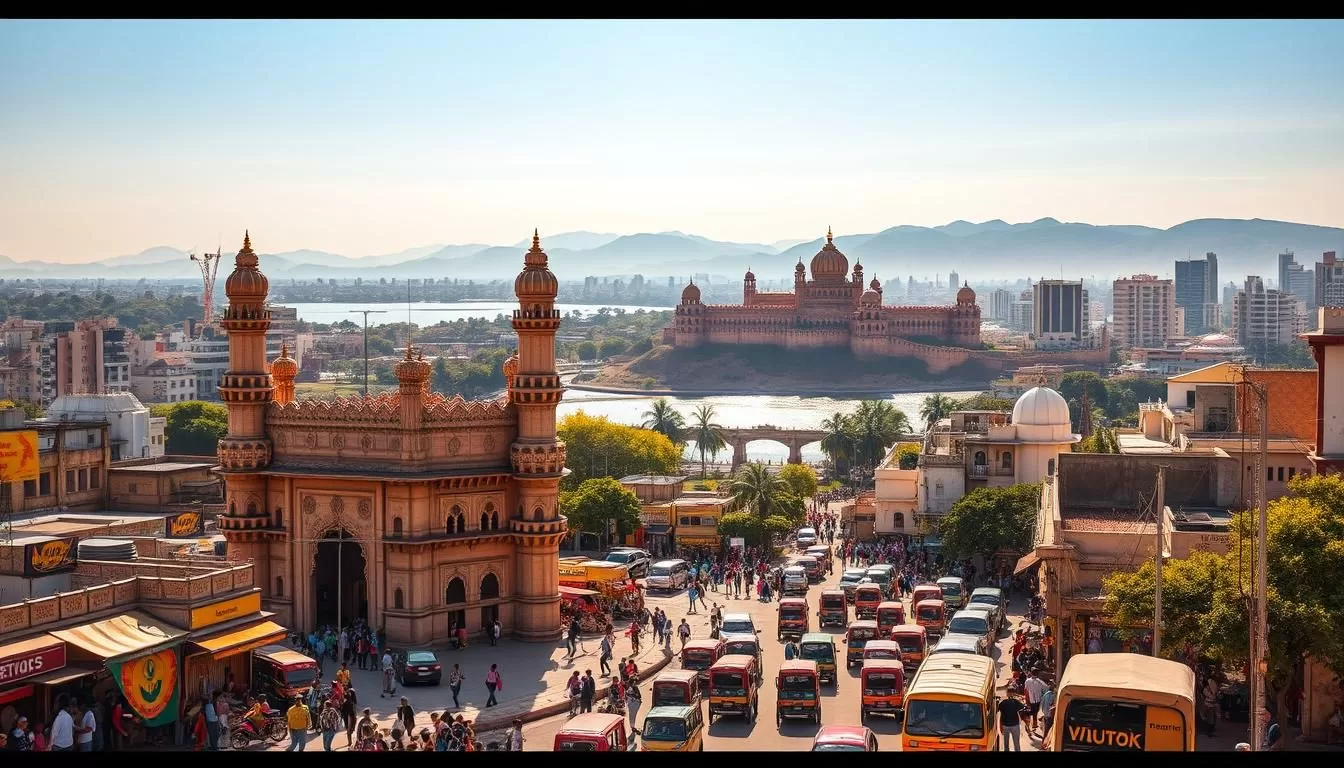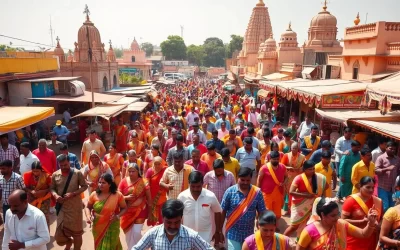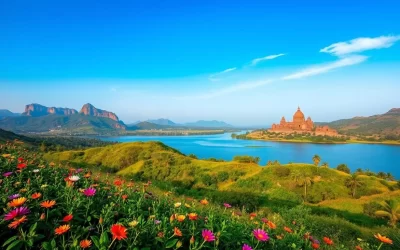Welcome to Hyderabad, a vibrant city where centuries of history blend seamlessly with modern attractions, creating an unforgettable travel experience.
You’ll discover why this metropolis is known as the “Pearl City” and how it offers a perfect mix of historical monuments, culinary delights, and cultural experiences.
This guide will walk you through the must-see attractions, from iconic landmarks to hidden gems that many tourists miss, helping you make the most of your visit to one of India’s most captivating destinations.
Discovering the Pearl City of India
Hyderabad, known as the Pearl City of India, is a treasure trove of historical landmarks, cultural richness, and vibrant markets. As you explore this city, you’ll uncover its unique blend of traditional and modern attractions.
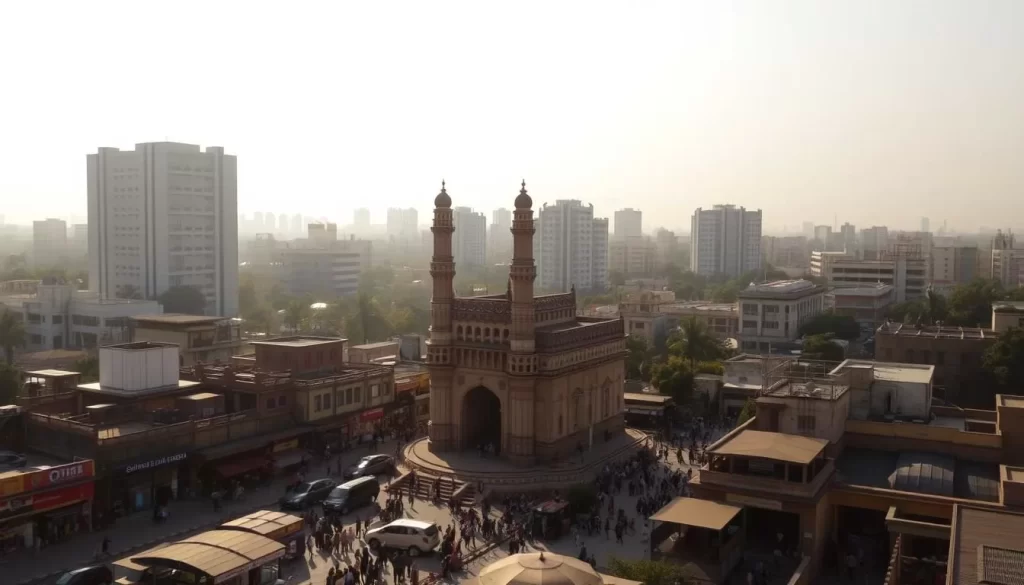
A Brief History of Hyderabad
Hyderabad’s fascinating journey began in 1591 when Muhammad Quli Qutb Shah established it as a new capital, moving from nearby Golconda Fort due to water shortages. The city flourished under the Qutb Shahi dynasty and later the Nizams, who were among the wealthiest people in the world during their reign. The Charminar, a historic 16th-century mosque, stands as a testament to the city’s rich history and architectural heritage.
When to Visit Hyderabad
The best time to visit Hyderabad is between October and March when the weather is pleasantly cool and dry, making it ideal for exploring outdoor attractions and places to visit in Hyderabad. Summer months bring intense heat, while the monsoon season offers relief with cooler temperatures but occasional heavy rainfall that might disrupt your sightseeing plans.
You can plan your trip according to your preferences, but generally, the period from October to March is considered the best time to enjoy the city’s offerings.
Explore the Iconic Charminar
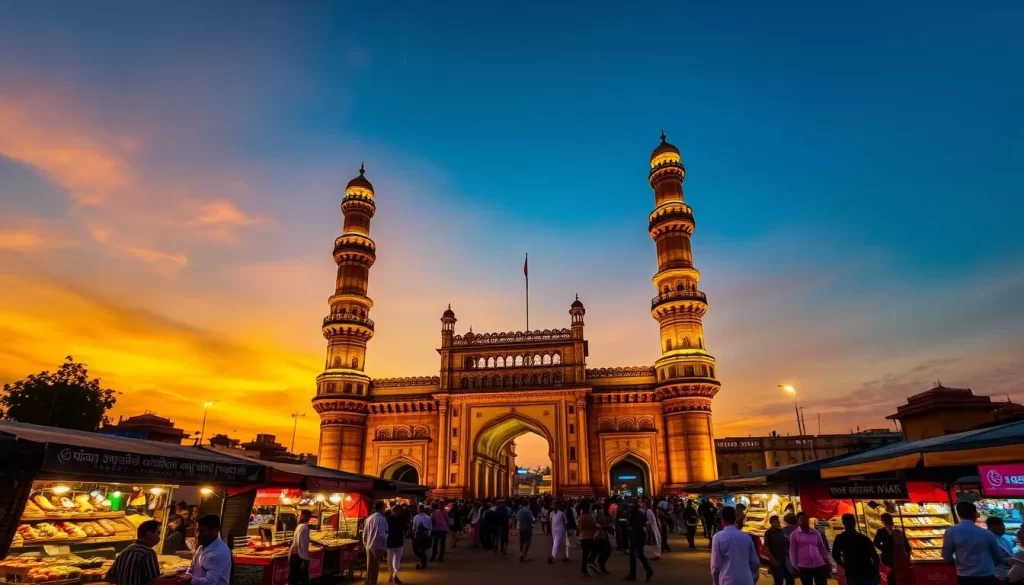
In the heart of Hyderabad lies the Charminar, a monument that has become synonymous with the city‘s identity. This historic structure is not just a testament to the city’s rich past but also a symbol of its cultural heritage.
The History and Architecture of Charminar
The Charminar, built in 1591 by Mohammed Quli Qutb Shah, is a masterpiece of Indo-Islamic architecture. The structure was erected to commemorate the end of a plague that had ravaged the region. Its name, meaning “four minarets,” refers to the four grand towers that stand tall, each 56 meters high. The mosque on the top floor is a serene spot amidst the bustling area. The Charminar’s design reflects the blend of Indian and Islamic styles, featuring arches, stucco work, and intricate details.
The construction of Charminar was a significant event, marking the shift of the capital from Golconda Fort to Hyderabad due to water shortages. This historical context adds depth to the monument’s significance.
Tips for Visiting Charminar
For a fulfilling experience, visit Charminar early in the morning to avoid the crowds and heat. Climbing to the first level offers panoramic views of the city. Take a moment to appreciate the mosque and the unique balconies at each corner. Be prepared for the vibrant market surrounding the monument, which is an experience in itself.
As you explore, notice the intricate details and the historical significance of the Charminar. It’s a place where the past and present converge, making it a must-visit destination in Hyderabad’s city landscape.
Step Back in Time at Golconda Fort
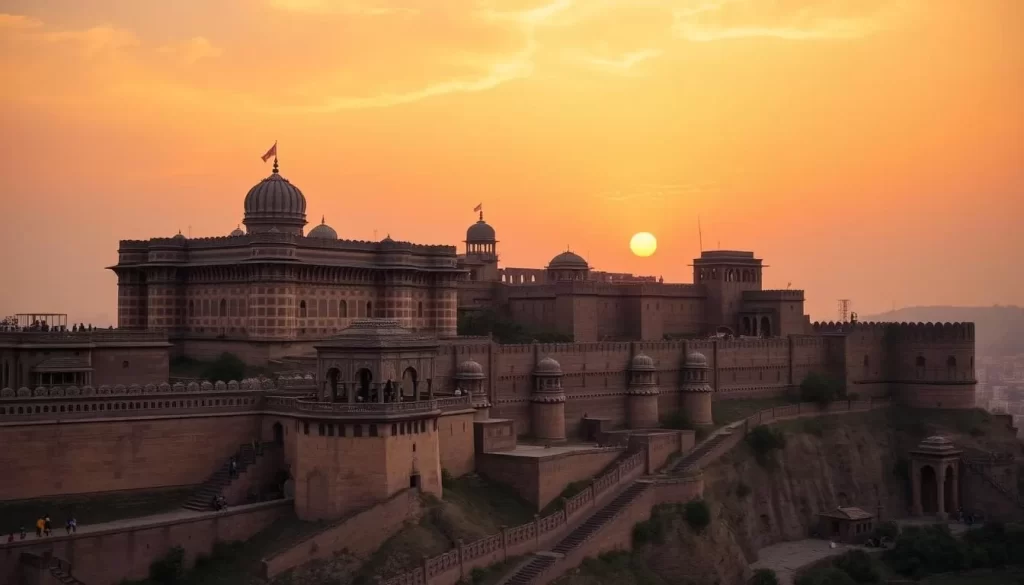
Golconda Fort, located to the west of Hyderabad, is a magnificent testament to medieval Indian engineering and architecture. Dating back to the 13th century as a mud fort, it evolved into an impressive stone fortress under the Qutb Shahi dynasty.
Exploring the Ancient Fortress
The fort stands atop a granite hill, offering commanding views of the surrounding landscape. Originally built as a mud structure, it was later fortified with stone and became renowned for its advanced water supply system and acoustic effects. You’ll be fascinated by the ingenious acoustic design that allows a handclap at the entrance dome to be heard at the hilltop pavilion nearly a kilometer away—a feature that served as an early warning system against attacks.
Don’t Miss the Sound and Light Show
The evening sound and light show is an absolute must-see, bringing the fort’s rich history to life through dramatic narration, music, and illumination that highlights the architectural features while telling stories of the fort’s former glory. The show is a spectacular way to experience the fort’s grandeur and understand its historical significance in the world context.
As you explore the vast complex, you’ll discover royal apartments, audience halls, temples, mosques, and stables. The fort complex requires at least 2-3 hours to explore properly, so plan your visit accordingly to soak in the history and architecture of this magnificent fort.
Experience Royal Luxury at Falaknuma Palace

Perched on a hill, Falaknuma Palace offers a glimpse into the opulent lifestyle of the Nizams who once ruled Hyderabad. This majestic palace, meaning “Mirror of the Sky,” is a must-visit destination for anyone looking to experience royal luxury.
The History of the Sky Palace
The Falaknuma Palace was built in 1894 by Nawab Vikar-ul-Umra, the Prime Minister of Hyderabad, as his residence. The Nizam was so impressed with the palace that he acquired it as a royal guesthouse for distinguished visitors. The palace’s scorpion shape and lavish interiors, featuring Venetian chandeliers and rare furniture, are a testament to its rich history.
Dining and Tour Options at Falaknuma
You can experience the grandeur of Falaknuma Palace through its Palace Tour and High Tea package. This includes a guided tour of the palace followed by an elegant afternoon tea service. For a more immersive experience, book a dinner at Adaa, the palace’s renowned restaurant, which serves authentic Hyderabadi cuisine with breathtaking views of the city below.
Whether you’re looking to dine like royalty or simply explore the palace’s opulence, Falaknuma Palace is a destination that promises an unforgettable experience in the heart of Hyderabad.
Discover Treasures at Salar Jung Museum

Hyderabad’s Salar Jung Museum is a must-visit destination for art lovers and history enthusiasts alike. The museum is renowned for its vast collection of art and antiques amassed by Nawab Salar Jung III.
The Salar Jung Museum is an outstanding art and antiques museum, located in the resident palace of Salar Jung III, the seventh Nizam’s Prime Minister, who established the museum. It houses one of India’s most impressive art collections, primarily acquired by Nawab Salar Jung III over 35 years.
Highlights of the Collection
The museum’s collection is diverse, featuring sculptures, paintings, textiles, manuscripts, and ceramics. One of its most famous attractions is the 19th-century musical clock, where a timekeeper emerges to strike the gong every hour. Another highlight is the Veiled Rebecca, a delicate marble sculpture by Italian artist Giovanni Maria Benzoni, known for its intricate craftsmanship.
Practical Information for Visitors
To make the most of your visit, plan carefully. The museum is closed on Fridays and requires at least 3-4 hours to explore properly. Additionally, photography is prohibited in certain sections. Arriving early in the day will help you avoid the larger crowds that gather by midday.
Visit the Qutb Shahi Tombs

Step into the Qutb Shahi Tombs, a necropolis that showcases the architectural prowess of the Qutb Shahi dynasty. The grand tombs of the seven Qutb Shahi kings, who ruled the region for almost 170 years, are situated just north of Golconda Fort. The oldest tomb dates back to 1543, and the Indo-Persian architecture on display is exquisite.
The Historical Significance of the Tombs
The Qutb Shahi Tombs complex houses the magnificent mausoleums of the seven rulers of the Qutb Shahi dynasty. You’ll be walking through a unique necropolis where the architectural style blends Persian, Pashtun, and Hindu influences. Each tomb follows a similar pattern—built on a square platform with a dome-shaped roof and intricate stonework—yet varies in size and decorative elements, reflecting the status and reign of each ruler.
The largest and most impressive tomb belongs to the dynasty’s founder, Sultan Quli Qutb Shah. The tombs were once decorated with chandeliers, carpets, and velvet canopies, but fell into disrepair after the Qutb Shahi dynasty came to an end in 1687. Fortunately, Salar Jung III had them restored during the early 19th century.
Tips for Exploring the Tombs
For the best photography opportunities, visit the Qutb Shahi Tombs in the early morning when the light is soft and golden, highlighting the architectural details. Be sure to wear comfortable shoes as exploring the entire complex requires considerable walking on uneven terrain. The nearby Paigah tombs, which date back to the late 18th century, are also worth visiting.
As you explore the tombs, take your time to appreciate the intricate stonework and the historical significance of the site. The Qutb Shahi Tombs are a testament to the rich history and cultural heritage of the city, making them a must-visit destination in Hyderabad.
Hyderabad, Telangana: Best Things to Do for Food Lovers
If you’re a food enthusiast, Hyderabad has a plethora of delicious experiences waiting for you. The city’s culinary scene is renowned for its rich flavors and diverse influences, making it a must-visit destination for anyone who loves food.
Must-Try Hyderabadi Biryani Spots
Hyderabadi Biryani is a signature dish that you can’t miss when in Hyderabad. This aromatic rice dish, cooked with meat and spices, has its roots in the Nizams’ kitchen. For an authentic taste, head to Hotel Shadab near Badshahi Ashurkhana or try the Paradise restaurant chain, both known for their delectable biryani.
| Restaurant Name | Location | Specialty |
|---|---|---|
| Hotel Shadab | Near Badshahi Ashurkhana | Hyderabadi Biryani |
| Paradise Restaurant | Multiple Locations | Hyderabadi Biryani |
| Bawarchi | RTC Crossroads | Hyderabadi Biryani |
Beyond Biryani: Other Local Delicacies
Beyond biryani, Hyderabad offers a variety of local delicacies that are worth trying. Haleem, a stew of meat, lentils, and wheat, is especially popular during Ramadan. You should also try Pathar ka Gosht, meat cooked on hot stones, and Qubani ka Meetha, an apricot dessert, to experience the full range of Hyderabadi cuisine.

Shop Till You Drop at Laad Bazaar

Laad Bazaar, stretching over 400 years, is a vibrant shopping destination that you can’t miss. Located near the iconic Charminar, this historic market is a treasure trove of traditional Indian goods.
Famous Bangles and Jewelry
Laad Bazaar is renowned for its stunning collection of bangles, a must-have for brides preparing for their weddings. The market is filled with lacquer bangles adorned with stones, making it a dazzling experience for shoppers. You can also find a variety of traditional Indian jewelry, including silver jewelry at Koti Sultan Bazaar, which is over 200 years old.
Bargaining Tips and What to Buy
When shopping at Laad Bazaar, bargaining is expected. Start by offering about 40-50% of the initial asking price and work your way up to a mutually agreeable figure. Be sure to maintain a friendly attitude and be prepared to walk away if you can’t reach a fair price. Beyond bangles, the market offers a range of products including traditional Indian clothing, embroidered sarees, pearls, semi-precious stones, perfumes, and handcrafted items that make perfect souvenirs.
Visiting Laad Bazaar in the late afternoon and staying until evening is recommended, as the market comes alive with lights, creating a magical atmosphere. Whether you’re looking for unique gifts or souvenirs, Laad Bazaar is a place where you can shop till you drop.
Take a Boat Ride on Hussain Sagar Lake

Experience the tranquility of Hussain Sagar Lake, a gem in Hyderabad’s heart. This artificial lake, built in 1562 during the reign of Ibrahim Quli Qutb Shah, offers a refreshing escape from the city’s hustle and bustle with its serene waters and cool breezes.
The Giant Buddha Statue
The lake is home to a massive 18-meter tall Buddha statue that stands majestically on Gibraltar Rock in the middle of the lake. Carved from white granite, it’s the world’s tallest monolithic Buddha statue and has become an iconic symbol of Hyderabad. You’ll be awestruck by this magnificent structure as you take a boat ride towards it.
Best Time for Boating and Activities
The evening is the perfect time to visit Hussain Sagar Lake. The temperature cools down, and the statue and surrounding areas are beautifully illuminated. You can enjoy the lively atmosphere along the promenade with food stalls and vendors. For families, the lake area offers numerous attractions, including Lumbini Park with its musical fountain show, children’s play areas, and laser show, making it an ideal spot for a relaxing evening with loved ones.
As you enjoy your boat ride, take in the spectacular views of the city skyline and the Necklace Road that curves around the lake. The boat ride to the Buddha statue is a must-do activity, with options ranging from regular ferry services to private speed boats. Whether you’re looking for a peaceful experience or an exciting day out with family, Hussain Sagar Lake has something for everyone.
Visit Ramoji Film City for a Day of Entertainment
![]()
For a day filled with excitement and glamour, head to Ramoji Film City, the world’s largest film studio complex. Spanning over 1,666 acres, it offers a fascinating glimpse into the world of movie-making. You’ll be amazed by the variety of film sets, including elaborate temples, streets, villages, and palaces that have served as backdrops for hundreds of films in multiple Indian languages.
Attractions Within the Film City
The film city is not just about film sets; it offers numerous attractions beyond, including stunt shows, a bird park, an Eco Zone, gardens, and themed restaurants. These make it a perfect day trip for families and film enthusiasts alike. You can explore the various film sets, watch live shows, and enjoy the different amenities available within the complex.
Tips for Making the Most of Your Visit
To ensure a comprehensive experience, opt for the guided tour package that includes transportation between major attractions within the vast complex, live shows, and access to most areas of interest. It’s advisable to visit on a weekday to avoid crowds and wear comfortable shoes for the considerable walking involved. If you want to explore without rushing, consider staying at the on-site hotel to spread your visit over two days.
Planning Your Perfect Hyderabad Itinerary
As you plan your trip to Hyderabad, it’s essential to create an itinerary that covers the city’s rich history, cultural heritage, and modern attractions. To make the most of your visit, consider a 3-day itinerary that includes a mix of historical sites, cultural experiences, and entertainment.
Start your first day by exploring the Old City area, visiting iconic landmarks like Charminar and Laad Bazaar, and sampling the city’s famous Hyderabadi biryani. On your second day, focus on historical sites like Golconda Fort and Qutub Shahi Tombs, followed by a visit to the Salar Jung Museum to admire its world-class collection.
Reserve your third day for modern attractions like Hussain Sagar Lake and Ramoji Film City. If you’re traveling with family, consider adding kid-friendly attractions like Nehru Zoological Park or Lumbini Park’s musical fountain show to your itinerary. For budget travelers, using the efficient Metro system to navigate between attractions and opting for group tours can help save time and money.
To make your trip even more enjoyable, consider staying in areas like Banjara Hills or Jubilee Hills, which offer convenient access to both historical and modern attractions. With this itinerary, you’ll be able to experience the best of Hyderabad and create unforgettable memories.
Whether you’re a history buff, a foodie, or an adventure-seeker, Hyderabad has something to offer. So, plan your trip, visit Hyderabad, and discover the city’s unique charm for yourself.
